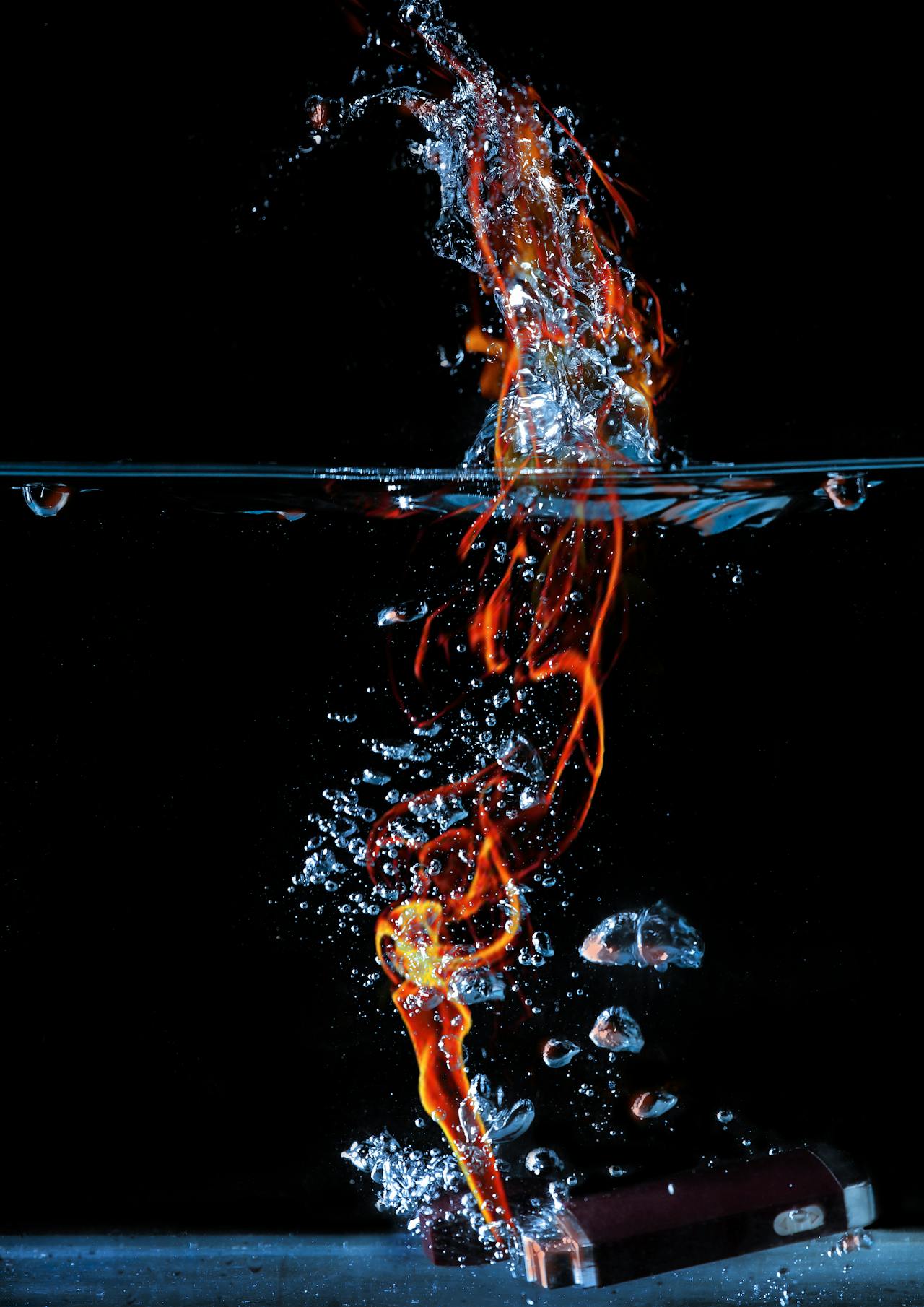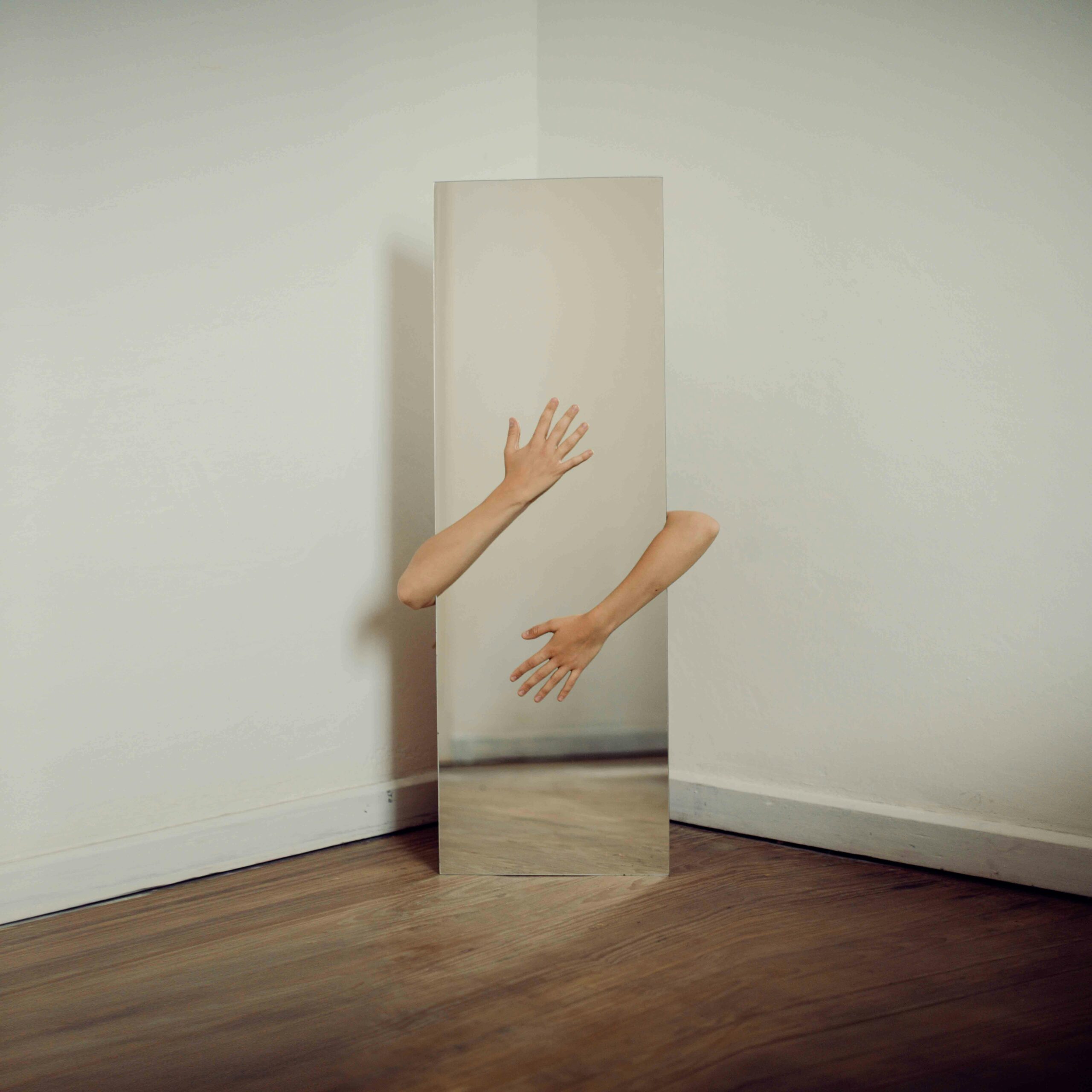Finding your voice can be difficult. That’s a subject often discussed, bandied about, and harped on in everything from writing classes to blogs (glances left and right) to podcasts. But forget that, that’s for another day. You know what’s tougher?* Changing your voice.
My voice, or at least in essay form, tends to be snarky, have asides, references, and flow fairly conversationally. I don’t like feeling constrained by formal strictures. Oh and occasionally I’ll slip in big words like strictures to show off that I’m not just some utter pleb who can’t grapple with more esoteric diction. But back to that point, I don’t generally follow the conventional 5-paragraph essay form or the stuffy school document form. Can I follow them? Yes, but now that I’m not turning in papers to be graded, I generally choose not to. And even in school I’d deviate.
For example, my (basically) thesis paper at the end of my English bachelor’s degree was for a class on feminism in literature and I researched on Frau Holda of Germanic myth as it corresponded to the importance of spinning in medieval cultures. (Did you know calling a female side of the family the “distaff” side was because of the distaff held by the spinner to hold the raw materials for thread? Also without people spinning thread almost constantly, people would barely have clothes at all. The spinning wheel wasn’t invented/in use in Europe until like the 18oos!) But when I finished writing up all my points, I was still 2 pages short. Now I could’ve dived back into the meat of the pages and added a few hundred words of educational filler words and drivel but I really didn’t want to. I could’ve researched another aspect but I liked the flow of the paper at present. So I wrote an intro and outro telling the story of a young girl listening to her mother tell her stories as she sat and spun. It wasn’t scholarly per se, but it tied the paper together and my teacher loved it and wanted to use my paper as an example for later classes. Hurrah! A win for voice!
But sometimes you do want to intentionally change your voice. And at this point and forward, I’m not just talking about voice in writing but voice and style in various creative endeavors. My clay creations have a definite flavor to them that differentiate them from others’. My artistic renderings are distinct from those that others may draw. My mom can pick out my standard horse drawing at about 1000 yards even now, I’m pretty sure. But that’s not always how I want my art to look. A friend and I were talking about how sometimes we’d prefer to change our natural style and do a more naturalist’s sketchbook style.
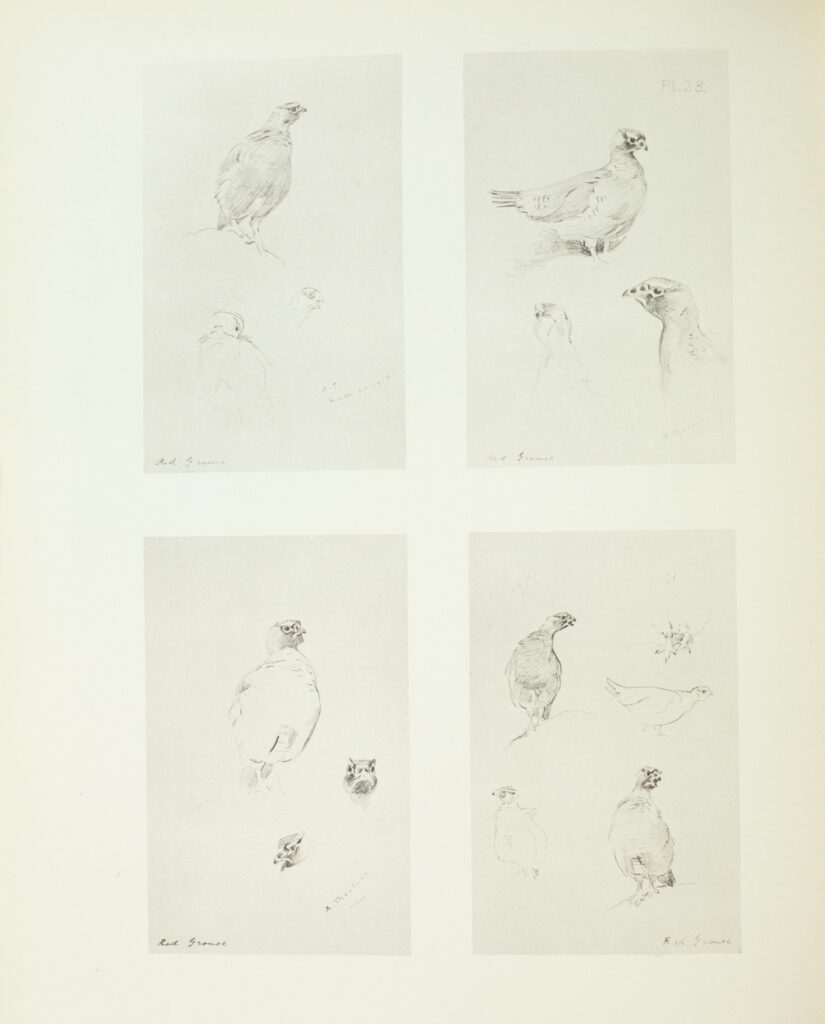
Changing your style fully is, I feel, difficult to do but you can do it if you do so intentionally. For me, the first step is finding what you want. Like the sketchbook above. But in this instance I’m going to follow my experience trying to recreate a specific style. Namely, film noir as presented by Tracer Bullet in Calvin and Hobbes.

I loved Calvin and Hobbes growing up. Wait, why is that past tense? I still love this comic. It’s real art. The things Bill Watterson can do with a black and white page and a little kid with his tiger is hilarious and heart-rending, occasionally in the same strip. And I always enjoyed when the style would abruptly change to show the world of Calvin’s imagination. And the style! When Bill Watterson drew the Tracer Bullet comics, of which there are sadly few, he made them more film noir than any movie or radio play or book of the era I know of, distilled and put into 4 panels at a time. I wanted to see if I could capture some of that essence myself.
We’re diving into the past now, so please bear with me. And if my current art isn’t up to the same snuff… please bear with me. Anyway. This was (counts) 13 or so years ago (and I had to dig up my old sketchbooks so please appreciate my efforts) and I was tossing around the idea for a picture book of a detective kid. Somewhere between Encyclopedia Brown and Tracer Bullet. They’d use the vernacular of film noir because they listened to a lot of plays and radio shows around their parents or something, but are solving more Encyclopedia Brown or Nate the Great type problems. Anyway, that’s the why, let’s talk the how. The first thing I did was imitative. Getting my fingers used to the flow. Getting my eyes and hands used to the shapes. And then I started iterating from there. Here’s a page from my sketchbook at the time:
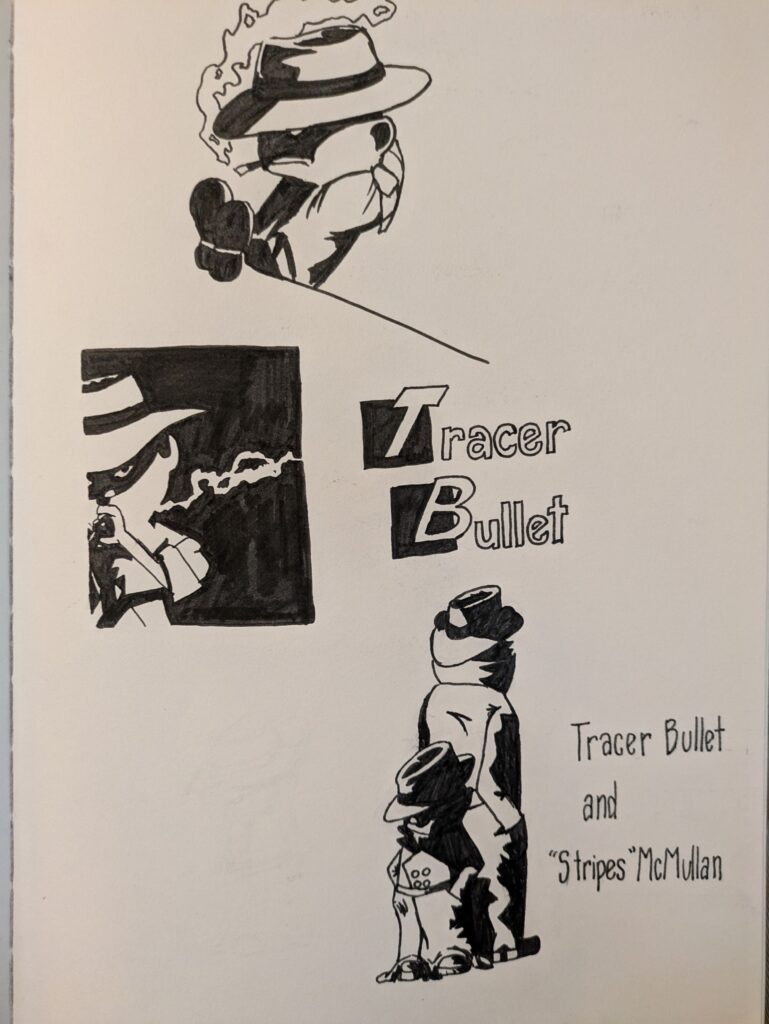
The last image on the bottom was my first try of making my own image using the style I’d been practicing. From there, I iterated further afield. What could I take from this style to add to images that I might create? I still used reference photos and style guides but for the most part, I was trying to mesh style from Tracer Bullet with something I might draw myself. Which is part of why, I think, this was easier than fully changing my style to a sketchbook style, for example.
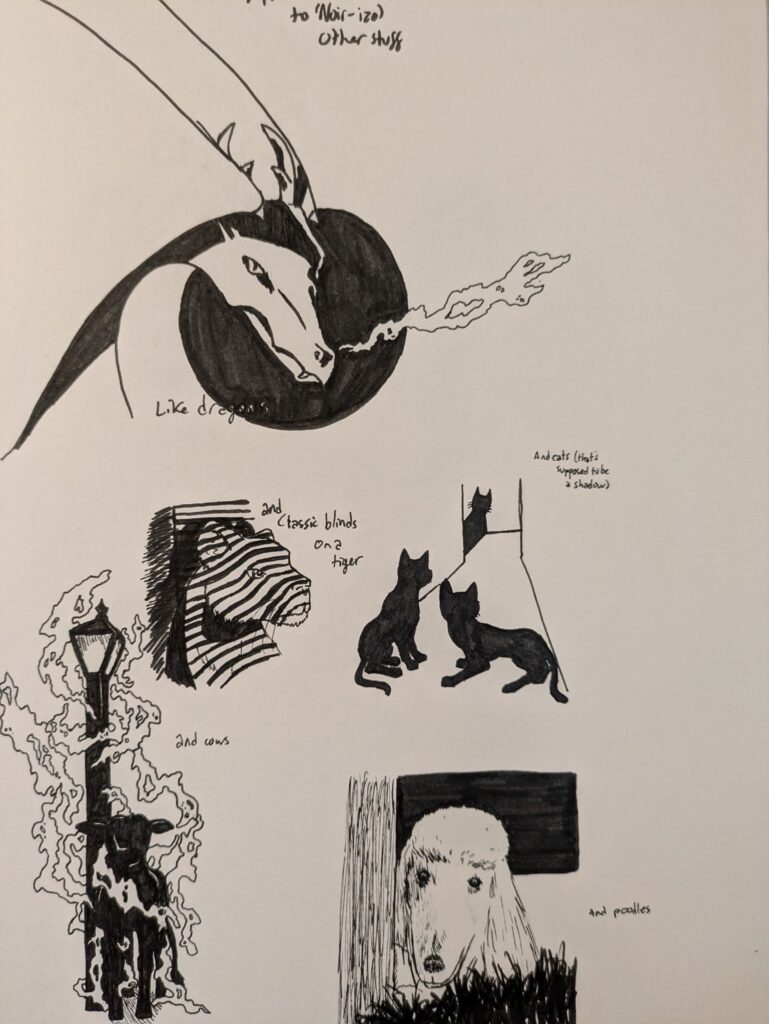
I mostly left it alone after the practice barring a few sketches here and there, trying to practice keeping the style alive. But I make this post because I’m coming back to it lately.
This touches on another project I’m working on. I’m trying to make images of a lot of different familiar and unfamiliar magical creatures and I’m trying to do them in 2 parts. The first part is just a mostly outline in my style (no, I’m not sharing that here yet, they’ll come later); the second is to create them in a different style. Painted, outlined, cartoon, chibi, medieval manuscript, whatever strikes my fancy when I start the second. And of course, enjoying what I did on this page, I came back to film noir. So enjoy a sneak peek of one of the ones I’m working on (that currently contains maybe 2% of the main feature of the image).
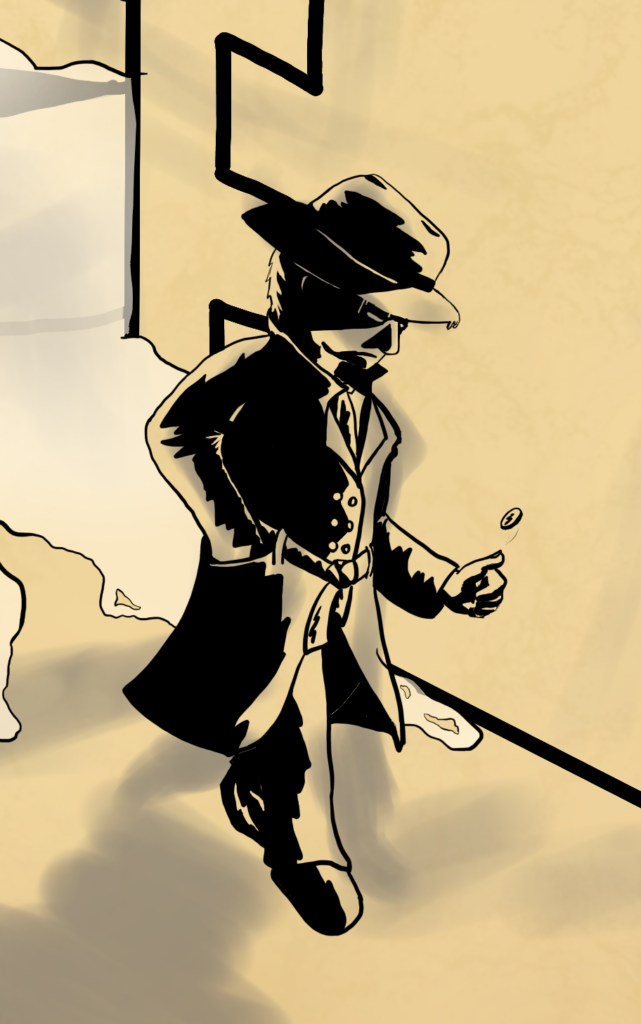
Speaking of changing style, if you back up to the varied film noir image and focus instead on the lettering, you’ll see another way I worked on changing style. I learned in middle school that I could change my handwriting through repeated effort; first I began writing smaller and smaller until I could fit 3 lines of notes on a single line in a notebook (look, Social Studies that year was paced for the kids who didn’t want to get it, I needed something to occupy me). Later I began learning to write backwards. After all, it was good for left-handed people who wanted to avoid resting their hands on the center spiral of their notebooks and smudging over their writing… which since I’m right-handed provided rather opposite opportunities for me. In college I worked on changing letters. I switched from the elementary style letter a, the circle with a tail at the back, to an a more like the ones in this font. I began adding loops and swirls and zig-zags to my lower letters like y, g, j, and q. And I, for a year or two, wrote my lower-case f’s in the almost S style of old manuscripts, as seen above. I practiced during note-taking in classes, reminding myself when I came upon the letters, to write them in the new style. It would take a few weeks or months of conscious effort but eventually the style became second nature, at least until I decided on a new shape to make my letters.
All of this to say, change is possible. Choose a pattern, decide what it’s going to be. If you’re having trouble doing it on your own, imitation is not only valid but really super helpful. Repeated effort. You’ll make mistakes (many of my sketchbooks contain images that say “yuck” or “nope” or “Eww, try again.”) but it’s possible. Some are harder than others; the more ingrained the habit, the more time it takes to dig a new course. But it works. It takes time but it works.
And sure, you can apply the same principles to life if you want to, just know that I refuse to be a life coach and I’m talking about art.
Intellectual Property of Elizabeth Doman
Feel free to share via link
Do not copy to other websites or skim for AI training
*Tougher in this case kind of depends tbh. It depends on if you’re breaking old habits or just using habits to build on a new method. Breaking old habits, as I just discussed with my kids re: fingernails and the peeling thereof, is difficult.

